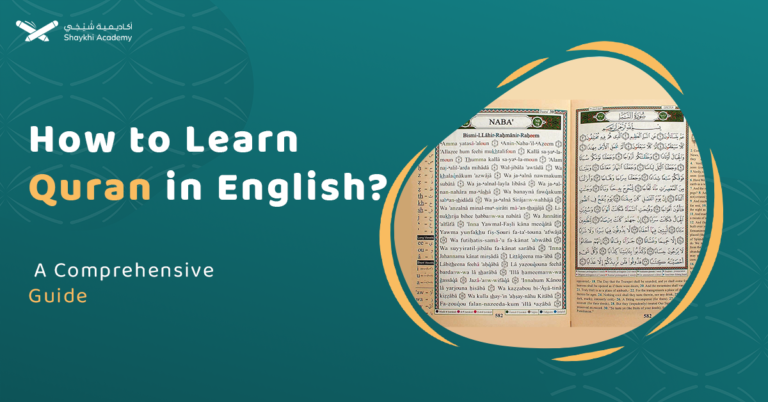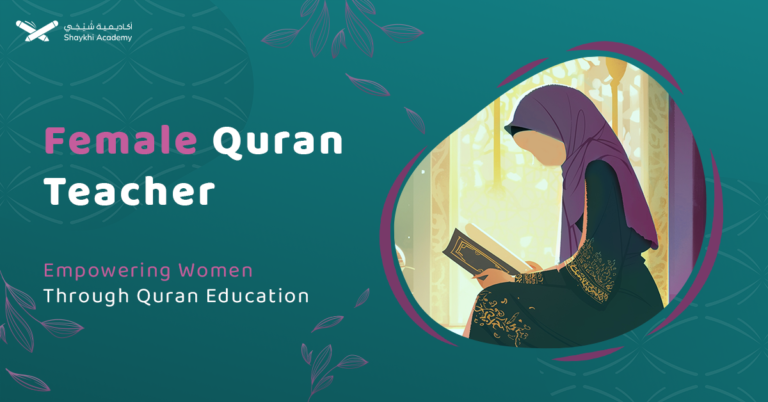Sifaat Al Huroof In Tajweed: The Arabic language consists of 28 letters, each with its own articulation point and distinctive quality. Some letters may share the same articulation point, which is why each letter is given a unique characteristic to distinguish it from the others.
Given that Arabic is the language of the Quran, the science of Tajweed (the art of Quranic recitation) includes an entire chapter dedicated to the articulation points and characteristics of the letters. Today, we will discuss the characteristics of the letters in Quranic recitation.
Characteristics of Letters in Tajweed (صفات الحروف في التجويد):
A characteristic is the manner in which a letter is pronounced, which distinguishes it from other letters. Understanding the characteristics of the letters allows us to:
Distinguish between letters that share the same articulation point (المخرج) by giving each letter its due characteristics.
For example, the letters “thaa” (ث), “dhal” (ذ), and “dha” (ظ) all originate from the tip of the tongue and the edges of the upper incisors. They are distinguished by giving each letter its proper characteristics.
Improve the pronunciation of the letters by giving each letter its due articulation point and characteristic. Identify strong and weak letters based on their characteristics, which helps in determining which letters can be merged (idgham), which cannot, and the extent of merging (complete or partial).
Categories of Letter Characteristics in Tajweed:
The characteristics of letters in Quranic recitation are divided into two main categories:
1. Permanent Characteristics(صفات لازمة):
These are intrinsic qualities that are always present in the letter. Examples include elevation (isti’laa), softness (leanness), and other characteristics.
2. Temporary Characteristics (صفات عارضة):
These are supplementary characteristics that occur under certain conditions and do not affect the intrinsic nature of the letter when absent.
Examples include thickening (tafkhim) (تفخيم), thinning (tarqiq)(ترقيق), merging (idgham)(إدغام), prolongation (mad)(مد), and concealment (ikhfa)(إخفاء).
3. Permanent Characteristics:
Scholars differ on the exact number of permanent characteristics, but the most widely accepted view is that there are seventeen permanent characteristics. These are divided into two groups:
A. Oppositional Characteristics:
There are five pairs of oppositional characteristics. If a letter possesses one of these characteristics, it cannot possess the opposite one. Every letter must have one characteristic from each pair. These characteristics are:
- Softness (hams) and its opposite, voicedness (jahr).
- Force (shiddah) and its opposite, looseness (rikhaawah), with moderation (tawasut) or in-betweenness (bainiyah) between them.
- Elevation (isti’laa) and its opposite, lowering (istifal).
- Tightening (itbaaq) and its opposite, opening (infitaah).
- Obstruction (ismaat) and its opposite, fluency (idhlak).
B. Non-Oppositional Characteristics:
These are seven characteristics that do not have opposites:
- Bouncing (qalqalah)
- Whistling (safee)
- Deflection (inhiraaf)
- Diffusion (tafashshi)
- Lengthening (istitaalah)
- Repetition (takreer)
Some scholars have added two more non-oppositional characteristics: concealment (ikhfaa) and nasalization (ghunnah).
To determine the characteristics of a letter, we first examine the oppositional pairs and assign one characteristic from each pair. This ensures that every letter has five oppositional characteristics. We then check for the presence of any non-oppositional characteristics and add them if applicable, resulting in a letter having a minimum of five and a maximum of seven characteristics.
Read more about huroof al muqatta’at tajweed
Strong, Weak, and Moderate Characteristics:
The permanent characteristics can be categorized as strong, weak, or moderate:
1. Strong Characteristics:
These include voicedness (jahr), force (shiddah), elevation (isti’laa), tightening (itbaaq), bouncing (qalqalah), whistling (safee), deflection (inhiraaf), and diffusion (tafashshi).
2. Weak Characteristics:
These include softness (hams), looseness (rikhaawah), lowering (istifal), opening (infitaah), and leanness (layn).
3, Moderate Characteristics:
These include moderation (tawasut), obstruction (ismaat), and fluency (idhlak).
Some scholars classify the characteristics differently, considering moderation and fluency as weak characteristics and obstruction as strong characteristics.
How to Determine the Characteristics of a Letter:
To determine the characteristics of any letter, follow these steps:
1. Review the oppositional characteristics:
Identify if the letter has any of these characteristics and note that it cannot have its opposite. These are the five characteristics that every letter must have.
2. Check the non-oppositional characteristics:
See if the letter possesses any of these characteristics. If it does, record this characteristic and add it to the previously identified five.
A letter cannot have more than seven characteristics and no less than five. Based on these characteristics, assess the strength or weakness of the letter.
Tajweed Sifaat Lazema Chart:
| Sifah | Meaning | Letters |
| Whispering (Al-Hams)(الهمس) | The flow of breath when pronouncing the letter | ف(faa).ح(haa),ث(thaa),هـ(haa) ش(sheen),ص(sad),س(seen),ك(kaf),ت(taa) |
| Voicedness (Al-Jahr)(لجهر) | The cessation of breath flow when pronouncing the letter due to the strong reliance on the articulation point | The rest of arabic letters except Hams letters |
| Force (Al-Shiddah)(الشدة) | The cessation of sound flow when pronouncing the letter due to the complete reliance on the articulation point. | أ(alif),ج(jeem),د(dal),ق(kaf),ط(taa),ب(baa),ك(kaf),ت(taa) |
| Moderation (Al-Tawasut)(التوسط) | The balance of sound when pronouncing the letter due to the partial cessation of the sound flow. | ل(lam),ن(noon),ع(ain),م(meem),ر(ra) |
| Looseness (Al-Rikhaawah)الرخاوة | The flow of sound with the letter due to the weak reliance on the articulation point. | The rest of arabic letters except shiddah and tawasut letters |
| Elevation (Al-Isti’laa)(الاستعلاء) | The raising of the tongue to the roof of the mouth when pronouncing the letter. | خ(kha),ص(sad),ض(dhad),غ(ghain),ط(taa),ق(kaf),ظ(dhaa) |
| Lowering (Al-Istifal)(الاستفال) | The lowering of the tongue to the floor of the mouth when pronouncing the letter. | The rest of arabic letters except (Al-Isti’laa) letters. |
| Tightening (Al-Itbaaq)(الاطباق) | The tongue’s close proximity to the roof of the mouth when pronouncing the letter. | ص(sad),ض(dad),ط(taa).ظ(dhaa) |
| Opening (Al-Infitaah)(الانفتاح) | The distancing of the tongue from the roof of the mouth to allow the breath to flow out. | The rest of arabic letters except (Al-Itbaaq) letters. |
| Extension and Leniency (Al-Mad wa Al-Layn)(المد واللين) | The elongation of sound and the effortless pronunciation of the letter. | ا(alif),و(waw),ي(ya) |
| Whistling (Al-Safeer)(الصفير) | The sharpness of the sound when pronouncing the letter. | ص(sad),س(seen),ز(zaa) |
| Diffusion (Al-Tafashshi)(التفشي) | The spread and relaxation of breath flow when pronouncing the letter. | ش(sheen),ث(thaa) |
| Lengthening (Al-Istitaalah)(الاستطالة) | The extension of sound from one edge of the tongue to the other. | ض(dad) |
| Repetition (Al-Takreer)(التكرير) | The slight vibration in the pronunciation of the letter “ر” (Ra) due to the tongue’s trembling. | ر(ra) |
| Deflection (Al-Inhiraaf)(الانحراف) | The deviation of sound from one characteristic to another. | ر(ra),ل(lam) |
| Nasalization (Al-Ghunnah)(الغنة) | A characteristic inherent to the letters “ن” (Nun) and “م” (Meem). | “ن” (Nun) and “م” (Meem) |
| Bouncing (Al-Qalqalah)(القلقلة) | The vibration at the articulation point when pronouncing the letter in a state of rest, producing a strong sound | ق(kaf),ط(taa),ب(baa),ج(jeem),د(dal) |
| Blowing (Al-Nafkh)(النفخ) | The sound produced when the letter is pronounced with pressure at its articulation point, which is less intense than bouncing. | ض(dad),ظ(dhaa)ز(zaa),ذ(dhal) |
Learn Tajweed with Shaikhy Academy
To learn the rules of Tajweed easily, quickly, and smoothly, enroll in Sheikhy Academy’s courses. We offer professional Tajweed courses suitable for all ages, with special courses for children and adults, both men and women.
With skilled and proficient teachers using engaging and innovative teaching methods, you can learn Tajweed correctly. Tajweed is a crucial science that regulates and enhances recitation, making you more proficient and skilled in reciting the Holy Quran.
Why Choose Shaykhi Academy?
- Connect with highly qualified native tutors.
- Flexible scheduling to suit your busy lifestyle.
- Affordable classes tailored for all levels.
- Accessible from anywhere around the globe.
Discover Our Range of Courses:
- Arabic Noorani Qaida: Lay a solid foundation for Quranic studies.
- Online Quran Classes for Kids: Engaging lessons for lifelong learning.
- Tajweed Rules for Kids: Learn to recite with confidence.
- Quran Hifz for Kids: Step-by-step guidance to memorize the Quran.
- Quran for Adults: Introduce yourself to Quran reading and Tajweed rules.
- Online Arabic Courses: Master the language of the Quran.
- Islamic Studies: A wide range of topics related to Islam, including theology, law, Quranic studies, and Hadith.
Don’t Miss Out on Your Chance to Excel! Whether you’re a beginner or seeking advanced knowledge, Shaykhi Academy can guide you! Book your free trial now
Conclusion:
Each letter of the Arabic alphabet has unique characteristics that distinguish it from other letters. Some letters may exhibit multiple traits.
To pronounce each letter of the Quran correctly, you need to understand its distinctive features. In this lesson, we have identified the characteristics of the letters and categorized them into essential and incidental traits.
Essential traits are inherent to the letter without external influences, while incidental traits depend on external factors such as hiding (Ikhfa), merging (Idgham), and turning (Iqlab).
We further divided the essential traits into two categories: traits that have opposites and traits that do not. We provided a table with the name of each trait, its definition, and an example of a letter exhibiting that trait from the Quran.
We hope this article is beneficial for anyone seeking to learn the science of Tajweed of the Holy Quran. We pray that Allah raises our ranks through the Quran.













































